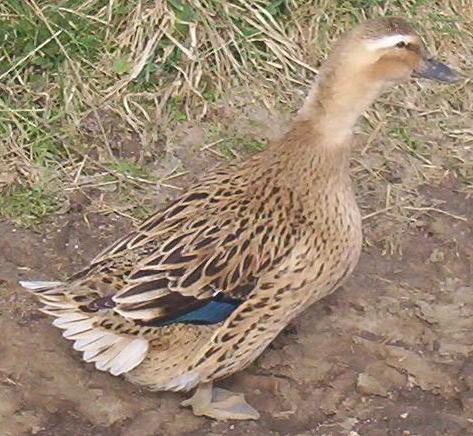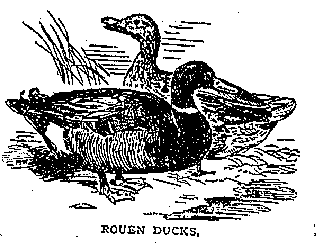Rouen (duck) on:
[Wikipedia]
[Google]
[Amazon]

 The Rouen is a heavyweight breed of
The Rouen is a heavyweight breed of
 The Rouen is a heavyweight breed of
The Rouen is a heavyweight breed of domesticated duck
Domestic ducks (mainly mallards, ''Anas platyrhynchos domesticus'', with some Muscovy ducks, ''Cairina moschata domestica'') are ducks that have been domesticated and raised for meat and eggs. A few are kept for show, or for their ornamental ...
. Rouens are raised primarily for meat, exhibition, or as general purpose ducks. Since they are not prolific egg layers, Rouen ducks are most commonly bred for their meat. The breed originated in France
France, officially the French Republic, is a country located primarily in Western Europe. Overseas France, Its overseas regions and territories include French Guiana in South America, Saint Pierre and Miquelon in the Atlantic Ocean#North Atlan ...
sometime before the 19th century.
Description
The plumage coloring of both the Rouen drake and the Rouen duck are nearly identical to that of theMallard
The mallard () or wild duck (''Anas platyrhynchos'') is a dabbling duck that breeds throughout the temperate and subtropical Americas, Eurasia, and North Africa. It has been introduced to New Zealand, Australia, Peru, Brazil, Uruguay, Arge ...
drake and Mallard duck. The Rouen color pattern is referred to as gray. Males have dark yellow bills, green heads, white collars, black tail coverts and dark, ashy brown tail feathers, a dark gray upper back and light gray lower body, a deep claret breast, and bright orange legs and feet. The female Rouen hens are a consistent shade of mahogany brown, with a brown crown and tan eye-stripes extending from bill to the back of the eyes, and a brown bill. Another feature of the female color pattern is the distinct, detailed penciling found on feathers of the head, neck, body, most of the wing and tail. Rouen females can be much darker brown than Mallard females. Both sexes also have blue speculum feathers
The speculum is a patch, often distinctly coloured, on the secondary wing feathers, or ''remiges'', of some birds.
Examples of the colour(s) of the speculum in a number of ducks are:
* Common teal and green-winged teal: Iridescent green ed ...
. However, Rouen speculum feathers are brighter in color and larger in size than that of the Mallard.
Adult Rouen ducks are typically significantly larger than Mallard ducks; their bodies tend to be longer and heavier than the Mallard. In North America
North America is a continent in the Northern Hemisphere, Northern and Western Hemisphere, Western hemispheres. North America is bordered to the north by the Arctic Ocean, to the east by the Atlantic Ocean, to the southeast by South Ameri ...
, two distinct types are bred: the common, or production-bred, variety that is larger than a Mallard but has a typical duck conformation, and the much larger and squarer standard-bred variety. The production variety normally weighs 6–8 lbs. (2.7–3.6 kg) while the standard-bred weighs 9–12 lbs. (4.1–5.4 kg). The production variety have a more upright carriage and slimmer body. The standard variety have a more horizontal carriage and a large, blocky body with the keel being deep and level.
The Rouen duckling is nearly identical to the Mallard duckling in terms of plumage coloring. Rouen ducklings can be distinguished from wild mallard ducklings by the presence of a second stripe which runs across their face, just under their eye, whereas mallard ducklings have only one stripe which runs across their eye.
These birds are of a docile and lethargic nature. Their larger bodies tend to inhibit the Rouen duck from sitting on a nest. Exhibition-typed Rouen ducks have been known to crush their eggs if allowed to set due to their massive frames. They mature slower than most other domestic duck breeds (6-8 months). They are often compared to the Pekin or Aylesbury
Aylesbury ( ) is the county town of Buckinghamshire, England. It is home to the Roald Dahl Children's Gallery and the Aylesbury Waterside Theatre, Waterside Theatre. It is located in central Buckinghamshire, midway between High Wycombe and Milt ...
breeds in both egg production and size. The Rouen is sometimes considered superior to these breeds, because they can be easily fattened, making them an excellent meat bird with delicate flesh.
History
The breed was first raised in France, but it was not until it reachedEngland
England is a Countries of the United Kingdom, country that is part of the United Kingdom. It is located on the island of Great Britain, of which it covers about 62%, and List of islands of England, more than 100 smaller adjacent islands. It ...
in the 19th century that it was refined into the breed recognized as the Rouen today. The French version resembled a larger than average Mallard, but by selective breeding, the British developed the exhibition-type Rouen. The final product was a bird with a deep, long keel, boat-shaped profile, enormous appearance, and refined markings, especially the penciling on the female. It was used chiefly as a roasting bird; though it produced 35 to 125 eggs a year, there were other breeds which were more reliable egg-layers with higher production. The eggs are typically white but can also be a blue-green color with thicker than normal shells. They average a weight of 3.5 oz. The French considered this domestic duck to represent the idea of "the Perfect Utility Duck." In 1861, Mrs. Beeton said of it:
The origin of the name is highly debated. When they arrived in England, they were variously called the Rhône, after the region in southwest-central France, Rohan, after the cardinal of that name, Roan, for the mixture of colors, and Rouen
Rouen (, ; or ) is a city on the River Seine, in northwestern France. It is in the prefecture of Regions of France, region of Normandy (administrative region), Normandy and the Departments of France, department of Seine-Maritime. Formerly one ...
after the northern French town, with Rouen eventually being adopted in both England and France. In France, they are called Rouen Foncé (dark) as opposed to Rouen Clair, which are lighter in color. These names arose from various English writers in the early part of the 19th century. B. Moubray was cited as calling it "the Rhone duck", yet Harrison Weir quotes "A Treatise on Poultry" (1810) naming them a "fine species that answers so well in the environs of Rouen, on the banks of the Seine." In 1875, J.K. Fowler, the leading authority on Rouens at the time, in "The Book of Poultry" declared: The Rouen Duck, which is only second to theIn 1850, the first Rouens were introduced to the United States by D. W. Lincoln ofAylesbury Aylesbury ( ) is the county town of Buckinghamshire, England. It is home to the Roald Dahl Children's Gallery and the Aylesbury Waterside Theatre, Waterside Theatre. It is located in central Buckinghamshire, midway between High Wycombe and Milt ...as a celebrity among our domestic waterfowl, most probably, as its name suggests, came originally from the city ofRouen Rouen (, ; or ) is a city on the River Seine, in northwestern France. It is in the prefecture of Regions of France, region of Normandy (administrative region), Normandy and the Departments of France, department of Seine-Maritime. Formerly one ..., inNormandy Normandy (; or ) is a geographical and cultural region in northwestern Europe, roughly coextensive with the historical Duchy of Normandy. Normandy comprises Normandy (administrative region), mainland Normandy (a part of France) and insular N ...; though some ingenious persons have tried to show that the name should be 'roan' and think that it was so called on account of its color, though why that particular color should be pitched upon from the many various ones its plumage contains it is hard to guess. It is far more probable that it is correctly called 'Rouen,' and that 'roan' is a corruption; for we know that quantities of poultry are raised in France, and Normandy is the most celebrated of the French provinces in this respect. We have however, no proof that the breed of ducks in question are especially the product of Rouen, though you may always see a large number of them, or at any rate, birds closely resembling them, for sale in the market place of that glorious old city.
Worcester
Worcester may refer to:
Places United Kingdom
* Worcester, England, a city and the county town of Worcestershire in England
** Worcester (UK Parliament constituency), an area represented by a Member of Parliament
* Worcester Park, London, Engl ...
, Massachusetts
Massachusetts ( ; ), officially the Commonwealth of Massachusetts, is a U.S. state, state in the New England region of the Northeastern United States. It borders the Atlantic Ocean and the Gulf of Maine to its east, Connecticut and Rhode ...
, and used as general farm ducks until becoming popular as show birds. They were included in the ''Standard of Perfection'' of the American Poultry Association
The American Poultry Association (APA) is the oldest poultry organization in North America. It was founded in 1873, and incorporated in Indiana in 1932.
The first American poultry show was held in 1849, and the APA was later formed in respons ...
in 1874 and since then have won many titles, often having the most entries in the heavyweight class and doing well in competition with other breeds. It was Mr. Lincoln who introduced the breed to the US, but John Giles was the poultryman instrumental in popularizing the breed among American poultry keepers. He had established his own Rouen flock by 1852, whether by buying Lincoln's own birds or importing his own. In 1854, he personally selected his own flock from England. After the Civil War, American Rouen ducks could be traced either directly to Giles' stock or indicated a strong probability of a relationship to it.
See also
*List of duck breeds
This is a list of the breeds of domestic duck which have official recognition at national or international level.
Most breeds of duck derive from the wild mallard, ''Anas platyrhynchos'', while a small minority are descendants of the Muscovy duc ...
References
* * {{Authority control Duck breeds Duck breeds originating in France Animal breeds on the RBST Watchlist Animal breeds on the GEH Red List